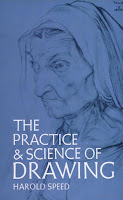 On the GJ Book Club, we're looking at Chapter 18: "Visual Memory" in Harold Speed's 1917 classic The Practice and Science of Drawing.
On the GJ Book Club, we're looking at Chapter 18: "Visual Memory" in Harold Speed's 1917 classic The Practice and Science of Drawing.The role of memory is a subject that's not often talked about in drawing books. I'll paraphrase the key points in my own words, followed by Speed's elucidation and a few comments.
1. The art that we've seen influences our perception of the world.
As Speed puts it: "After seeing the pictures of some painter whose work has deeply impressed us, we are apt, while the memory of it is still fresh in our minds, to see things as he would paint them."
The greatest tribute we can give to artists of the past is that we see the world in terms of their artwork: We see in nature a Turner sky, a Maxfield Parrish dusk, a Wyeth barn, or a Rockwell character.
 |
| How many of us have seen a tree as a "Rackham" tree? |
He says, "The intense individualism of the English sought out every detail, every leaf and flower for itself, painting them with a passion and intensity that made their painting a vivid medium for the expression of poetic ideas; while the more synthetic mind of the Frenchman approached this search for visual truth from the opposite point of view of the whole effect, finding in the large, generalised impression a new world of beauty."
Note that by "synthetic" he means unifying separate elements into a whole. He doesn't mean our modern sense of synthetic as "artificial." This is a fascinating way to look at the two outdoor painting movements, which are so different in their goals and results.
3. Observation without memory leads to commonplace results.
This is a wake-up call to the contemporary "plein-air painting" movement, and also to our contemporary obsession with taking photos of everything as a substitute for memory. Speed says "the system of painting continually on the spot is apt to lose touch with [the artistic impulse]."
This can especially be a problem in commercial "plein-air paint outs" where the whole idea is to go to a place we have no feeling for, and quickly hunt down a subject that we hope will have the greatest likelihood of selling that day for the maximum price.
In N.C. Wyeth's letters, he talked about the painters who would arrive in the Brandywine Valley on weekends to "bag a landscape" the way trophy hunters would "bag" big game in Africa. For both N.C. and Andrew Wyeth, the inspiration for painting outdoors always began in the memory and the imagination, and they already knew the painting they wanted to paint before heading outdoors to nature.
 |
| Isaac Levitan, Such moonlight scenes could only have been painted from memory |
a. Memory retains essential things, and discards non-essentials.
b. We can make better pictures if we cultivate the "flashes of inspiration," that we see fleetingly, often in momentary light or transitional moments.
5. Memory can be trained.
It's not easy at first, but there are systems. He mentions the memory drawing school of Monsieur Lecoq de Boisbaudran. Speed recommends that "What students should do is to form a habit of making every day in their sketch-book a drawing of something they have seen that has interested them, and that they have made some attempt at memorising. Don't be discouraged if the results are poor and disappointing at first—you will find that by persevering your power of memory will develop and be of the greatest service to you in your after work."
6. Don't chase effects.
Every landscape painter learns this the hard way. Changing light, especially on a partly cloudy day, presents one inspiring light effect after another. But once you commit to a particular one, you have to stick to it and not be lured away by another effect. That requires the discipline of memory.
Feel free to offer your comments on any of the points mentioned above, or other points I may have missed.
-----
The Practice and Science of Drawing is available in various formats:
1. Inexpensive softcover edition from Dover, (by far the majority of you are reading it in this format)
3. Free online Archive.org edition.
Articles on Harold Speed in the Studio Magazine The Studio, Volume 15, "The Work of Harold Speed" by A. L. Baldry. (XV. No. 69. — December, 1898.) page 151.
and The Windsor Magazine, Volume 25, "The Art of Mr. Harold Speed" by Austin Chester, page 335. (thanks, अर्जुन)
GJ Book Club on Pinterest (Thanks, Carolyn Kasper)
GJ Facebook page
Overview of the blog series
Announcing the GJ Book Club
Chapter 1: Preface and Introduction
Chapter 2: Drawing
Chapter 3: Vision
Chapter 4: Line Drawing
Chapter 5: Mass Drawing
Chapter 6: Academic and Conventional
Chapter 7: The Study of Drawing
Chapter 8: Line Drawing, Practical
Chapter 9: Mass Drawing
Chapter 10: Rhythm
Chapter 11: Variety of Lines
Chapter 12: Curved Lines
Chapter 13: Variety of Mass
Chapter 14: Unity of Mass
Chapter 15: Balance
Chapter 16: Proportion
Chapter 17: Portrait Drawing
Chapter 18: Visual Memory
Chapter 19: Procedure
Chapter 20: Materials
Overview of the blog series
Announcing the GJ Book Club
Chapter 1: Preface and Introduction
Chapter 2: Drawing
Chapter 3: Vision
Chapter 4: Line Drawing
Chapter 5: Mass Drawing
Chapter 6: Academic and Conventional
Chapter 7: The Study of Drawing
Chapter 8: Line Drawing, Practical
Chapter 9: Mass Drawing
Chapter 10: Rhythm
Chapter 11: Variety of Lines
Chapter 12: Curved Lines
Chapter 13: Variety of Mass
Chapter 14: Unity of Mass
Chapter 15: Balance
Chapter 16: Proportion
Chapter 17: Portrait Drawing
Chapter 18: Visual Memory
Chapter 19: Procedure
Chapter 20: Materials


Thanks for this. I've been beating myself up lately for not getting great, quick, plein-air paintings outdoors. It seems this is expected of landscape painters, and there's a lot of pressure to perform. I've never considered myself a 'hit-and-run' painter, and prefer to sit (or stand) calmly in nature adding images to the mental library as well as to the sketchbook.
ReplyDeletePoint number 4 really hit me in the gut. This is exactly what I am struggling with, both in drawing and in photography, and I had no idea. I will take the suggestions in number 5 and make it part of my practice from now on.
ReplyDeleteExactly as above, The point 4(b) is particularly spot on. That's what I've always tried to cultivate. And I rely first and foremost on those fleeting images and vision to guide me through the paintings.
ReplyDeleteNo.3 touched me the most, albeit all are valid. I completely agree about the common place aspect to a lot of work out there, as yet the big "Plein Air" festivals have yet to have a massive effect on art in the UK. But I belive good artists are like a sieve, with a memory and biase that filters to what rings true to their indvidual quirks. It's comforting to hear that you think Levitan painted the nighttime scene from visual memory, seems clear now....
ReplyDeleteThis comment has been removed by the author.
ReplyDeleteLecoq had a great system for training the visual memory. I had a teacher long ago who pushed memory drawing and I think it is a great thing to add to your studies. Even working from nature memory is required. You look at nature, but as soon as you turn to your canvas, you are working from menory
ReplyDelete#4 (mostly). It's not just that we should memorize the essentials of what inspires us but the recognition of why that which inspires us in the first place can and should be preserved (and how). By learning to memorize those things I think we learn to better understand or recognize the things that we individually find inspiring in the first place. So often I find inspiration but rarely take the time to really understand why. Like so many other things he talks about in the book, it comes down to a matter of really seeing and studying something in order to better (best?) express it. Great and inspiring chapter!
ReplyDeleteI find it interesting that when painting in a new place, whether in a competition or on a painting trip, my first effort is usually my best. I think it's because my emotional energy is at a peak when I first get there. Every painting I do at that place or event may be strong but the first usually has little extra something...
ReplyDeleteI would have to say No.3 hit home with me the most after being frustrated with my plein air results.
ReplyDeleteThrough my study and research I realized that most of the landscape artist I truly admired where not alla-prima on the spot producing those works but using a combination of studies in pencil and oil, working plein air and in the studio with work based on much direct observation and informed memory.
The Isaac Levitan is a perfect example.
Almost all of the art I created in my youth was related to comic books. I started by copying artists I admired but eventually I created my own characters and comics. Just about all that art is created from memory. Figures, interiors, exteriors, landscapes, portraits and every detail within are drawn from the artists experiences and memories of those experiences. It was a great way to (unintentionally) hone my visual memory skills.
ReplyDeleteA good book for developing skills for memory drawing is "Memory Drawing: Perceptual Training and Recall" by Darren R. Rousar. He writes: "All drawing and painting from life is at some point done from memory, even if that memory is only seconds old.....Inness claimed that many of his best landscape paintings were done from memory. (This book) will help you remember fleeting effects, seize essentials, and even enhance your imagination".
ReplyDelete